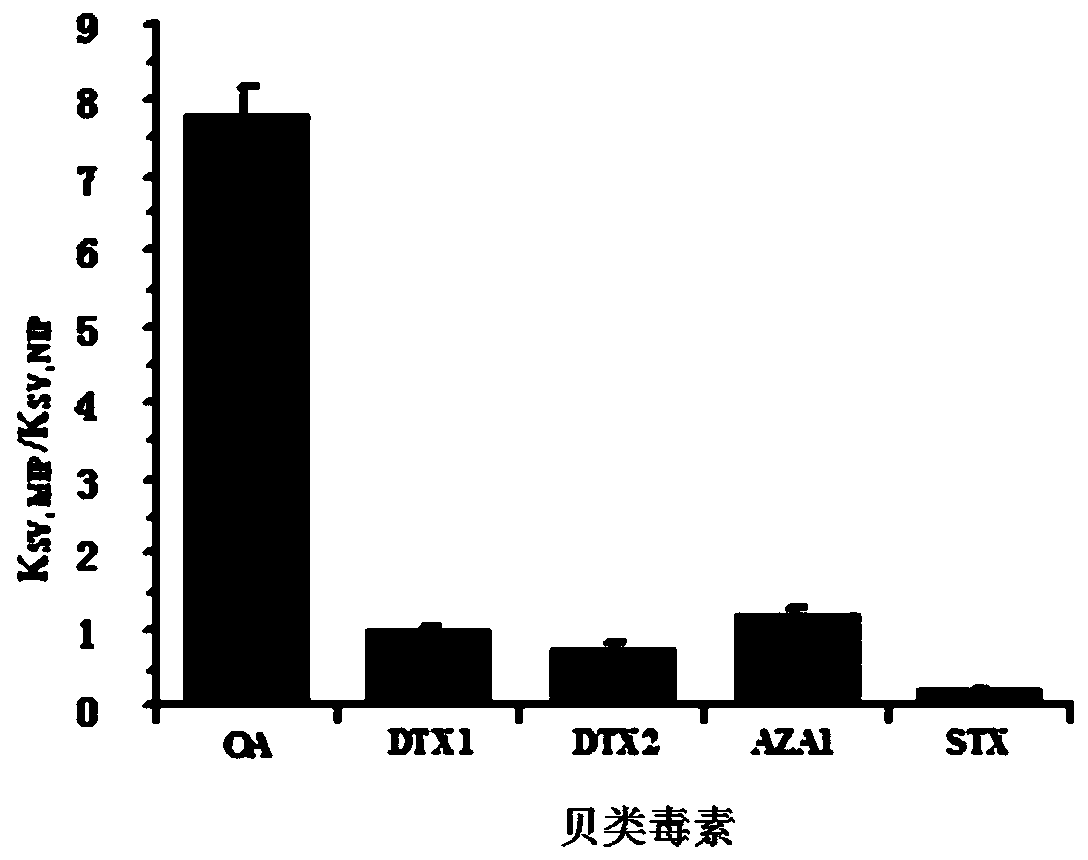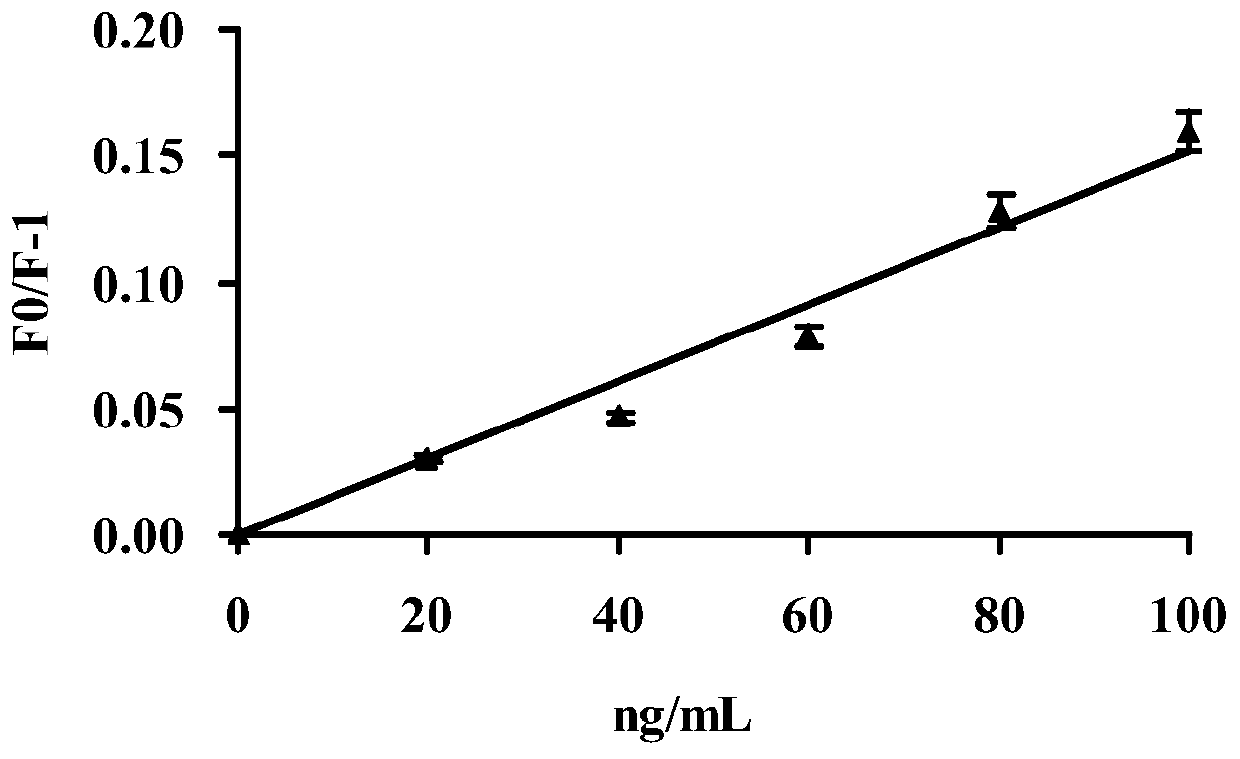A kind of preparation method and application of halichondrin molecularly imprinted-quantum dot polymer
A quantum dot polymer, soft sponge acid technology, applied in the fields of material science and analytical chemistry, can solve the problems of high operator requirements, high pretreatment requirements, expensive equipment, etc., to achieve less consumption of organic solvents, less sample requirements, Easy-to-use effects
- Summary
- Abstract
- Description
- Claims
- Application Information
AI Technical Summary
Problems solved by technology
Method used
Image
Examples
specific Embodiment 1
[0022] A method for preparing the molecularly imprinted-quantum dot polymer of halicic acid toxin, comprising the following steps: taking haicic acid as a template molecule, adding quantum dot fluorescent nanomaterials, and adding a cross-linking agent tetraethyl orthosilicate TEOS and a functional monomer Under existing conditions, after initiating the polymerization, the template molecules in the obtained polymer are removed by an ultrasonic-assisted extraction method, and the halicic acid toxin molecular imprint-quantum dot polymer that can specifically recognize the haicic acid toxin is obtained. Specific steps are as follows:
[0023] (1) After mixing 7.5 mL cyclohexane and 1.8 mL Triton X-100 and stirring for 15 min, add 500 μg of quantum dot fluorescent nanomaterial QDs, 50 μL of tetraethyl orthosilicate (TEOS ) and 100 μL of ammonia water, and stir for 2 h , and finally add 156 μL of halicic acid toxin solution with a concentration of 1 μg / mL, functional monomer 3-amin...
specific Embodiment 2
[0030] Utilize the molar imprinting-quantum dot polymer of the halicic acid toxin prepared in the above specific embodiment 1 to detect the content of haiconic acid, the specific steps are as follows:
[0031] (1) Weigh 0.02-0.05 mg of Molecularly Imprinted Molecularly Imprinted-Quantum Dot Polymer of Halicic Acid Toxin and dissolve it in 0.5-1.0 mL of ethanol to obtain a homogenate, and transfer the homogenate into a polypropylene Spin solid-phase extraction chamber under vacuum. In the column, the halicic acid toxin molecularly imprinted-quantum dot polymer is compressed through the upper sieve plate and the lower sieve plate to obtain the halicic acid Spin solid phase extraction column; then the halicic acid Spin solid phase extraction column is sequentially washed with ethanol 0.5-1mL, 10wt% ethanol aqueous solution 0.5-1mL rinse activation;
[0032](2) Accurately weigh 1.0 g shellfish sample, add 2.0 mL methanol, homogenate at 12000 rpm for 30 s, vortex shake for 5 min, c...
specific Embodiment 3
[0034] 1. High selectivity (specificity)
[0035] Molecular imprinting of soft spongy acid toxin-quantum dot polymer synthesized by using soft spongy acid (OA) toxin as a template molecule, select fin toxin 1 (DTX1), fin toxin 1 (DTX2), orthopolygalginic acid (AZA1) , saxitoxin (STX) as a structural analogue, the specificity of the obtained MIP-QDs was analyzed (the fluorescence quenching system is represented by the equation, F 0 / F =1+ Ksv [Q], F 0 and F represent the initial fluorescence value of MIP-QDs and the fluorescence value after adding cypermethrin, respectively, Ksv is a constant parameter in the Stem-Volmer equation and [Q] is the concentration of the quencher. ( F 0 -F ) represents the fluorescence quenching value before and after adding cypermethrin, ( F 0 - F ) / F is the imprinting efficiency of MIP-QDs. MIP-QDs and NIP-QDs Ksv The ratio of values represents the imprinting factor ( IF ), used to evaluate the selectivity of MIP-QDs). Ex...
PUM
| Property | Measurement | Unit |
|---|---|---|
| particle diameter | aaaaa | aaaaa |
Abstract
Description
Claims
Application Information
 Login to View More
Login to View More - R&D Engineer
- R&D Manager
- IP Professional
- Industry Leading Data Capabilities
- Powerful AI technology
- Patent DNA Extraction
Browse by: Latest US Patents, China's latest patents, Technical Efficacy Thesaurus, Application Domain, Technology Topic, Popular Technical Reports.
© 2024 PatSnap. All rights reserved.Legal|Privacy policy|Modern Slavery Act Transparency Statement|Sitemap|About US| Contact US: help@patsnap.com










